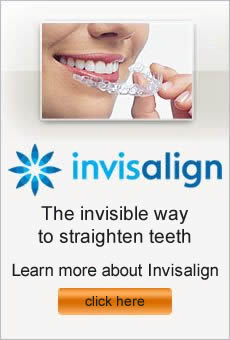When you wear braces, you probably can’t wait for the day your orthodontist takes them off and you can flaunt a beautiful, straight smile. Orthodontic treatment, however, doesn’t end with braces. Most of the time, your orthodontist will fit you for a retainer, an oral appliance that keeps teeth from shifting back into an improper position. You may wear a removable retainer as well as one that stays inside your mouth.
Initially, you will need to wear the removable retainer for most of the day. Over time, your orthodontist will watch your teeth and may lessen the number of hours you wear the appliance. For children and teenagers, many orthodontists recommend wearing a retainer until their early 20s. To keep your retainer in good condition, follow these helpful hints:
- Remove your retainer when you eat, brush, or floss.
- Clean your retainer with warm, soapy water or toothpaste after each use.
- Put your retainer in a safe place when you aren’t wearing the appliance. People often remove their retainers at restaurants and place them in napkins, which can result in expensive replacement costs.
- Carry your retainer case with you so that you have it available at all times. Never leave the case on a table, bench, or counter.
- Keep your retainer away from pets or small children.
- When you participate in sports, take your retainer out and wear a mouth guard during games.
- If a wire breaks or something else happens to your retainer, don’t try to fix it yourself. Contact your orthodontist immediately.
Schedule an appointment for your child at our Valley Village, CA orthodontists office.
The spookiest night of the year is drawing close, and your little ghouls and goblins will be heading out to scare the neighbors and score some treats. You probably already know most of the safety rules when it comes to trick-or-treating, such as carrying a flashlight and wearing light-colored or reflective costumes. Another big one is inspecting the treats before your kids dig in, to make sure all the candy is safe. However, have you thought about looking at the candy for the purpose of making sure it’s acceptable for your child’s braces-clad teeth?
Your child’s orthodontist probably warned you to steer clear of certain foods that are known to commonly break or bend braces. Some of these items are pretty easy to avoid most of the time, but a jack-o-lantern full of candy can be very tempting. Many of the popular treats that your child may collect when trick-or-treating fit the guidelines of being hazardous to teeth undergoing orthodontic treatment. Here are some items to avoid:
• All hard candies
• All chewy candies
• Nuts
• Licorice
• Caramel
• Taffy
• Jelly beans
• Bubblegum
• Popcorn
• Hard pretzels
• Caramel and candy apples
This may seem like a list that will take all the fun out of Halloween, but there are still many treats that your child can enjoy. Some braces-friendly examples are plain chocolate candy, peanut butter cups, sliced apples, and soft cookies and cupcakes. Just remember to look for treats that aren’t sticky, chewy, hard, or crunchy. Also, most parents tend to give their children a free pass about indulging in sweets on Halloween, but don’t forget your regular brushing and flossing routine. Maintaining healthy teeth will help you have a hauntingly good time on Halloween, and throughout the year!
Nearly 4 million children under the age of 18 in the United States and Canada are currently wearing braces. How do you know if your child should be one of them? Here are some guidelines to help you decide.
Purpose
Braces are used to move teeth into the best position, but remember that braces are not only about appearance. They fix minor problems from slightly crooked teeth to serious issues like jaw disorders. With treatment, your orthodontist can repair overbites, underbites, and reposition teeth. Orthodontics may also correct problems like speech impediments, TMJ pain, and teeth grinding.
Age
The American Association of Orthodontics (AAO) recommends that kids have their first orthodontic consultation by age 7 so that your orthodontist can take preventative actions and possibly avoid the need for braces in the future. Usually, children get braces between the ages of 10 and 14 because kids in this range have some permanent teeth and are still growing. Your dentist is a great resource for telling you if your child, regardless of age, should see an orthodontist. Because 25 percent of today’s orthodontic patients are adults, any individuals with concerns should schedule an orthodontic consultation.
Warning Signs
You may observe some obvious signs that braces are in your child’s future, such as very overcrowded or crooked teeth. Some kids may have trouble chewing or closing their lips over their teeth. If children grind their teeth or have a history of thumb-sucking, orthodontic problems may arise. Early or late tooth loss is another sign that braces may be necessary as your child grows.
Recommendation
Keep in mind that a dentist’s or orthodontist’s recommendation does not mean that you have no choice about your child’s treatment plan. Make sure you understand the reasons for the suggested treatment, and ask any questions you may have. Don’t hesitate to get a second opinion so that you are completely confident in the decision you are making about your child’s smile.
The specialty in dentistry that focuses on the diagnosis, prevention, and treatment of malocclusions, orthodontics allows dental providers to straighten teeth and improve your oral health. Modern advances now give patients more options for treatment. If you are considering orthodontic therapy for your self or a loved one, the following questions can help give you more information during the decision-making process.
What is the difference between an orthodontist and a dentist?
All orthodontists are dentists, but not all dentists are orthodontists. In addition to dental school, orthodontists must complete another two to three years of specialized training.
When should my child see an orthodontist?
The American Association of Orthodontists (AAO) suggests that all children have an initial evaluation by age seven.
What is Phase I orthodontics?
Orthodontic treatment between ages six and ten years old is referred to as Phase I therapy. The goal of early orthodontics is to correct issues that respond best to treatment before growing is complete.
Am I too old for orthodontic treatment?
You are never too old to enjoy the benefits of a healthy, straight smile. Roughly one-third of orthodontic patients are adults. Options like lingual braces, ceramic brackets, and clear aligners enable adults to maintain their mature images while they transform their smiles.
How long will orthodontic treatment last?
The length of your therapy depends on several factors, including severity of the problem, compliance with instructions, and movement of your teeth. On average, orthodontic treatment lasts about 18 months.



